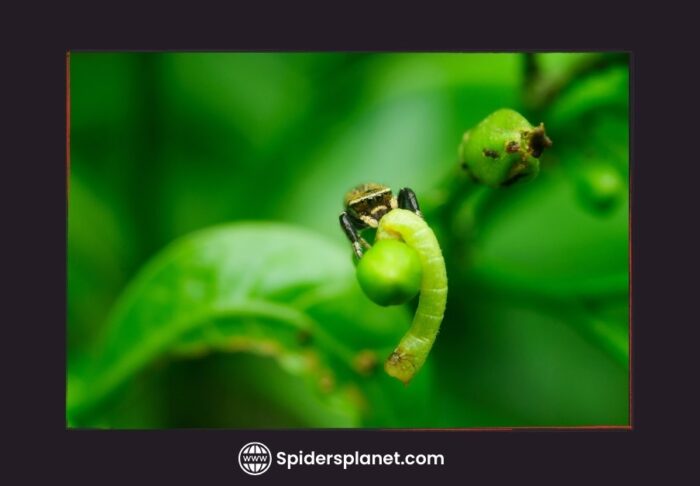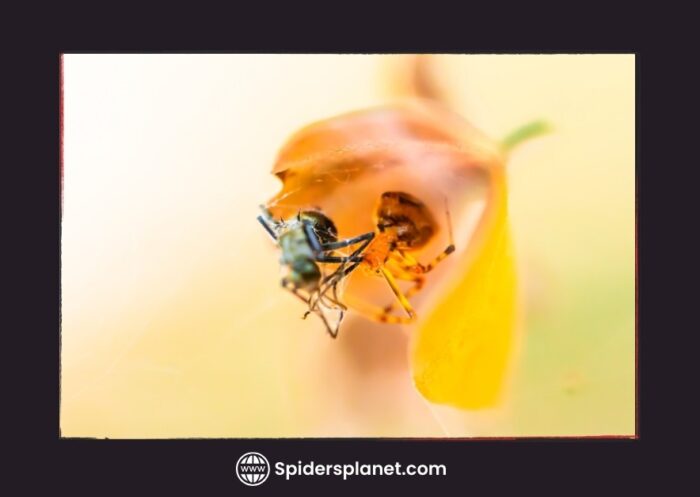The connection between animals and fruits showcases a captivating example of mutualism, a win-win relationship where both parties benefit.
Animals gain access to essential nutrients and sugars from the fruits they consume, while fruits depend on animals to spread their seeds, ensuring their continued growth and survival.
Surprisingly, a wide range of animals enjoy eating fruits! In fact, a significant part of the animal kingdom (Frugivores) relies heavily on fruits as their primary food source.
But you will be curious to know, “Do spiders eat fruit?”. We often see spiders as experts in catching bugs with their webs, thinking of them as dedicated carnivores.
While they are great at trapping flies and mosquitoes, it turns out that some spiders have a sweet tooth for a different treat – fruit! However, fruit is not the main dish for these eight-legged pals.
Let’s dive into the specifics of a spider’s diet, particularly exploring whether they like to have fruits in their diets.
If the answer is yes, then we will learn which fruits find their way into the diet of spiders. Curious to know? Keep reading…!
What Do Spiders Like to Eat and Drink?
A Brief Overview:
Most spiders are carnivores, and their diet mainly consists of insects like:
- Ants
- Bugs
- Butterflies
- Earwigs
- Fleas
- Flies
- Grasshoppers
- Locusts
- Moths
- Roaches
- Spiders
Sometimes even earthworms. They use their special skills, like making webs and having a bite that carries venom, to create an excellent buffet full of insects.
This buffet is like a balanced meal for them, providing lots of protein and important nutrients.
But there is more to the spider’s menu! Depending on the type of spider and where they live, they can be quite versatile eaters.
Jumping spiders, for instance, sometimes enjoy sipping nectar from flowers, adding a bit of sweetness to their insect-focused meals.
The majestic orb weavers, known for their spiral webs, have surprised researchers by capturing and eating small lizards, frogs, and even birds.

Just like us, spiders need water to stay alive, but their way of drinking is pretty unique. Instead of using their mouths, they absorb water through tiny hairs on their legs and abdomens.
It is like sipping a milkshake through a straw made of your fuzzy parts. That’s how a spider hydrates! So, the next time you see a spider, remember there is more to their dining habits than just catching bugs in their webs.
Diversity of Spider Species & their Specific Feeding Habits:
Spiders are like superheroes, with over 48,000 different types, each having its special way of eating.
Some, called orb weavers, make sticky webs to catch bugs like the Golden Orb Weaver that loves big feasts. Spitting spiders from South America spit sticky silk to catch their meals.
Jumping spiders, like the Zebra Jumping Spider, jump around and bite bugs with their venom.
Wolf spiders, such as the Giant Huntsman Spider, run fast to catch insects and even tiny animals. Diving bell spiders, like the one in Europe, build webs underwater and use air bubbles to breathe while waiting for bugs.
And there are social hunters in Southeast Asia that live together, making huge webs and sharing their food.
Each spider adds a cool chapter to the big story of spider life, so when you see one, think about the amazing adventure it has with every bite it takes.
Do Spiders Really Eat Fruitage?
Spiders are mostly carnivores and like to eat insects and bugs. They eat other animals to survive, and fruit is not their go-to meal.
They have special bodies made to break down and use the proteins and fats from insects, other spiders, and even small animals.
However, in some tropical places with lots of fruit trees, a few spiders might sneak a bit of fruit nectar or juice.
They cannot really eat the fruit’s flesh, just the sweet liquid. Jumping spiders and orb weavers are cool examples that sometimes sip nectar from flowers or fruits.
Also, spiders might not directly eat the fruitlet, but they can catch bugs attracted to it, making the fruitlet a handy friend for the spider’s meal.
While it is not usual for spiders to munch on fruit, it is not impossible. They mostly stick to their animal-based diet, where they are the bug-catching champions.
Spiders Species Who Eat Fruitage or Drink Juice?
While most spiders are strict carnivores, relying solely on animal prey for sustenance, some surprising exceptions have been observed, occasionally enjoying a taste of sweetness from fruit nectar or juices.
Jumping spiders, known for their acrobatic skills, have been seen sipping nectar from flowers and fruits like bananas and watermelons.
Orb weavers, the architects of intricate webs, also join in on the sweetness by indulging in sips from fruits like grapes and mangoes.
Read Also: Are Woodlouse Spiders Venomous?
Why Don’t Most Spiders Eat Fruitage?
Most spiders stick to a meaty diet, and there are good reasons for that!
First, Spiders primarily follow a carnivorous diet, well-suited for their bodies designed to process animal proteins and fats efficiently.
They are not equipped to handle the carbs and sugars found in fruits; it just would not work. Upon capturing prey, spiders inject venom to immobilize it, transforming its internal structure into a liquid form.
The spider then positions itself strategically, equipped with sharp fangs and a powerful sucking organ called a pharynx located under its body.
Instead of swallowing the prey whole, the spider pierces its body, injecting digestive enzymes that break down the liquefied tissues into a nutritious soup.
The spider then uses its pharynx like a straw to slurp up this liquid feast, absorbing the nutrients directly into its stomach through tiny tubes.
This external digestion process, known as extracellular digestion, allows spiders to consume large prey while maximizing nutrient absorption efficiently.
Also, spiders are excellent hunters, using their webs, bites, and sharp senses to catch live prey efficiently. Hunting is much easier for them than waiting for fruit to fall.
Fruits might have some sugars and vitamins, but they lack the important proteins and fats that spiders need to grow and stay energetic.
However, in some places with lots of fruit or when live prey is scarce, a few spiders, like jumping spiders and orb weavers, might enjoy some fruit juice.
They cannot eat the flesh, but they use clever tricks to sip the sweet liquids. Also, even if spiders don’t munch on the fruit directly, the yummy smell can attract bugs for them to catch.
So, while fruits are not the main dish for spiders, they can sometimes be a tasty snack or a helpful way to find more bugs to eat.
Why Do Some Spider Species Have Fruitage in Their Diet?
These fruit-eating spiders might opt for a sweet treat for a nutritional boost in environments with scarce insect prey, find hydration in arid regions, or attract prey with the aroma of ripe fruits.
It is crucial to note that such behavior is rare and opportunistic, with the majority of spiders remaining dedicated to carnivores, emphasizing the importance of animal matter in their diet.

Even for those few species that enjoy fruit occasionally, it is not their main food source, and they can only access sugary liquids or soft pulp, lacking the ability to digest the entire fruit.
Do Spiders Eat Vegetables?
Bagheera kiplingi is a unique spider residing in trees, especially those of the Mimosaceae family, like Vachellia trees.
These spiders have a distinct diet, feasting on special parts of the tree called Beltian bodies, rich in proteins and fats.
Growing at the tips of acacia leaves, these bodies are part of a teamwork agreement with certain ants despite the ants’ attempts to guard them. Cleverly avoiding the ants, the spiders get most of their food from these bodies, over 90%.
They also enjoy nectar and occasionally snatch ant larvae for a quick snack, even consuming other spiders, particularly during dry times. Tests reveal their food is mostly plant-based, resembling herbivores.
Their method of eating and processing Beltian bodies remains a mystery, differing from spiders that use digestive juices to turn prey into liquid.
In Mexico, they are largely herbivorous, residing in over half of specific trees, while in Costa Rica, they eat fewer plants and live in fewer trees.
Though they usually live alone, sometimes hundreds of these spiders are found on one tree, with more females than males.
They seem to have babies throughout the year, displaying hints of social behavior when adults care for their young.
Except for Bagheera kiplingi, most spiders, similar to fruits, do not typically eat vegetables due to their digestive systems not being suited for breaking down plant materials.
However, there are intriguing exceptions where spiders engage with vegetables in unique ways. Some, like jumping spiders, unintentionally aid in plant reproduction by picking up pollen on their bodies while searching for prey.
Despite these interesting interactions, the majority of spiders maintain their predatory nature, relying on their specialized adaptations for hunting and digesting insects for survival.
Concluding Thoughts:
While spiders are primarily carnivores, some, like jumping spiders and orb weavers, may occasionally enjoy fruit nectar or juices in tropical regions.
However, this sweet indulgence is a supplement rather than a main course, and their predatory instincts, showcased through hunting skills and specialized diets, prevail in their survival strategy.
FAQs:
Can I feed a spider human food?
Most spiders are obligate carnivores, meaning they require animal protein and fats for survival.
Their digestive systems are not adapted to handle the complex carbohydrates and sugars found in human food.
Feeding them unsuitable food can lead to digestive problems and malnutrition.
Do spiders eat fruit in the winter?
No, most spiders do not actively eat fruitage, and even the few that do, like jumping spiders, are more likely to do so in tropical regions with abundant fruit trees.
In winter, fruit is typically scarce, and spiders rely on their usual prey, like insects and other small animals.
Can spiders eat apples?
While they might take a sip of nectar or extract liquid from overripe fruits, spiders cannot digest the fruit flesh due to their lack of specific enzymes.
Do cellar spiders eat fruit flies?
No, cellar spiders are primarily insectivores and would not typically seek out fruit flies.
Do jumping spiders eat fruit flies?
Yes, adult jumping spiders are agile hunters and can capture and eat fruit flies as part of their diverse diet.
Do wolf spiders eat fruit flies?
Wolf spiders are also carnivores and rarely eat fruit flies unless they are exceptionally hungry or with limited insect prey options.




Leave a Reply